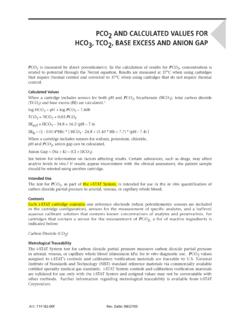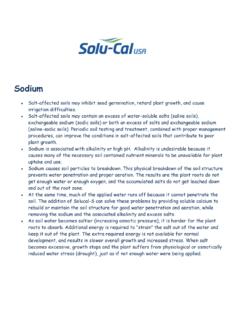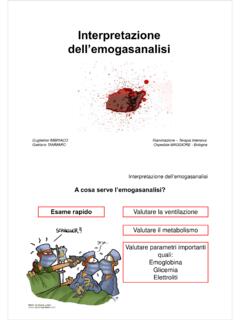Transcription of CaCO3 (s) O 2 (aq) Ca(HCO 2 (aq)
1 KARST LANDSCAPE. WHAT IS KARST: Karst terrain is typically formed when easily dissolvable bedrock, such as the limestone found here in southeast Minnesota, is carved out over time to form a subterranean labyrinth of channels. The limestone bluffs, sinkhole, blowhole, and disappearing river found along the Lost Creek Hiking Trail are all terrain features that are associated with karst topography. Beneath this limestone layer is a mainly impermeable layer, the Decorah shale, which limits downward movement of ground water so it flows laterally over the shale. When the water intersects with the land's surface on a valley slope, it outlets in the form of springs. Since the groundwater readily enters the aquifer and does not have a long latency time, groundwater safety is an important concern for residents in this part of southeast Minnesota. CHEMISTRY OF LIMESTONE DISSOLUTION. Limestone is a sedimentary rock that by definition is composed of at least 50% though usually more than 80% calcium carbonate ( CaCO3 ).
2 Most of the calcium carbonate in limestone comes from the compaction of seashells and coral. The calcium carbonate reacts with H2CO3, which formed in the atmosphere from water and carbon dioxide, to produce components that are soluble in water. CaCO3 (s) + H2O(l) + CO2 (aq) Ca(HCO3) 2 (aq). H2O + CO2 H2CO3. 2+. CaCO3 + H2CO3 Ca + 2 HCO. 2+ 2 . CaCO3 Ca + CO3. Ca(HCO3) 2 (aq) CaCO3 (s) + H2O(l) + CO2 (aq). 2 . CO3 + H2CO3 2 HCO3. TERRAIN FEATURES. Limestone is relatively impermeable, and water initially dissolves the rock along cracks and fissures at the surface, gradually expanding them into large vertical shafts known as joints. These joints intersect bedding planes, or distinct strata, of a lesser degree of solubility to form a grid-like network of passages. Throughout this network the air temperature remains a constant 48 degrees Fahrenheit year-round, representing the average annual temperature. The blowhole along Lost Creek Hiking Trail is an example of a joint connected to a network of passages.
3 Air flow into sinkholes in the uplands moves through the underground passages where it cools in summer and warms in the winter to emerge through the blowhole. During the summer a cool breeze can be felt emerging from the blowhole, while in the winter a warm mist can be seen. When these cavities are large enough for human entry and exploration they are referred to as caves. While not all caves are made of limestone, most of the hundreds of caves that can be found in Fillmore County are. Of all of these caves only Mystery Cave and Niagara Cave are open to the public. The study of caves is known as speleology, and cave formations are known as speleothems. They are created when the saturated water formed from limestone dissolution contacts air and precipitates back into limestone, essentially reversing the process. Stalactites and stalagmites are two commonly encountered speleothems. Stalactites are the icicle-like projections that form from water droplets hanging from the ceiling. Water dripping from stalactites produces corresponding structures on the cave floor; these are stalagmites.
4 Stalactites and stalagmites can join together over time to form a column. Videos on cave formation: 1.) Planet earth: Cave formation (purchase full video here). 2.) TMW Media Group Video (purchase full video here). The Swiss cheese landscape below is not without physical manifestations at the surface. Streams in the area often lose water into or gain water from the ground in the form of sinks and springs respectively. Streams can disappear entirely or emerge seemingly out of nowhere rather than simply following the contour of the land. A blind valley, according to the oxford dictionary, is a steep-sided valley in an area of karst scenery which ends in an abrupt cliff facing up the valley. At this point the overland drainage disappears down a stream sink. Another striking feature of southeast Minnesota is the absence of natural lakes; this is not solely due to increased porosity. Most of Minnesota is dotted with glacial lakes but this region escaped glaciation, giving rise to the nickname of driftless area , referring to the lack of glacial drift.
5 Moth Spring, Forestville Township, Fillmore County Sinkholes are arguably the most visible reminder of the geologic processes that occur underneath our feet. They form when the water dissolution of underlying bedrock creates a conduit for material to funnel into. If the surface adjusts to this subsurface erosion the sinkhole will form gradually; this is known as a subsidence sinkhole. If the surface does not adjust to this erosion, a void may form and ultimately collapse the material above; this is known as a catastrophic sinkhole . The average sinkhole is 10 to 40 feet in diameter and 5 to 40 feet deep. They most commonly form on flat hilltops adjacent to or between stream valleys. Sinkhole prevalence has increased in recent years due to human activity, and the redirecting of ground water for agricultural use. *Some parts of Fillmore County are designated as sinkhole plains , where up to several hundred sinkholes per square mile can be found. This picture is from a field in Fountain the self-proclaimed sinkhole capital of the *.
6 WATER QUALITY. The direct connection of surface runoff to underlying water-table aquifers affects groundwater quality and contamination is a major concern in many karst areas. In southeast Minnesota, relatively thin soils compound the problem and further decrease the residence time the amount of time it takes water leaving the atmosphere to enter the groundwater. Additionally, sinkholes had historically been used as dump sites for undesirable waste. Nowadays they are often sealed off due to the safety and environmental hazards they pose. For farmers with sinkholes on cropland, the Conservation Reserve Program offers compensation in exchange for a maintained buffer zone of natural vegetation around the sinkhole. USEFUL RESOURCES: WATER QUALITY IN KARST AREAS. Karst Waters Institute Water Quality in Relation to Vegetative Buffers Around Sinkholes in Karst Terrain Article on manure lagoons in karst areas SINKHOLE TREATMENT. - sinkhole treatment SINKHOLES IN FILLMORE COUNTY: GENERALIZED KARST/CAVE INFORMATION: LIMESTONE INFORMATION: EXCELLENT KARST VIDEO: IMAGES: Karst drawing INDIVIDUAL CAVES.










